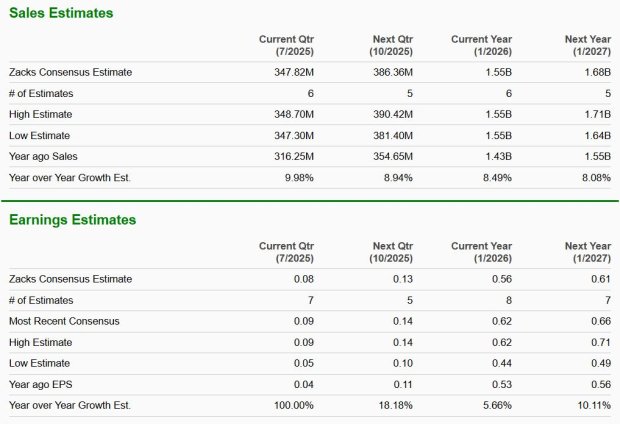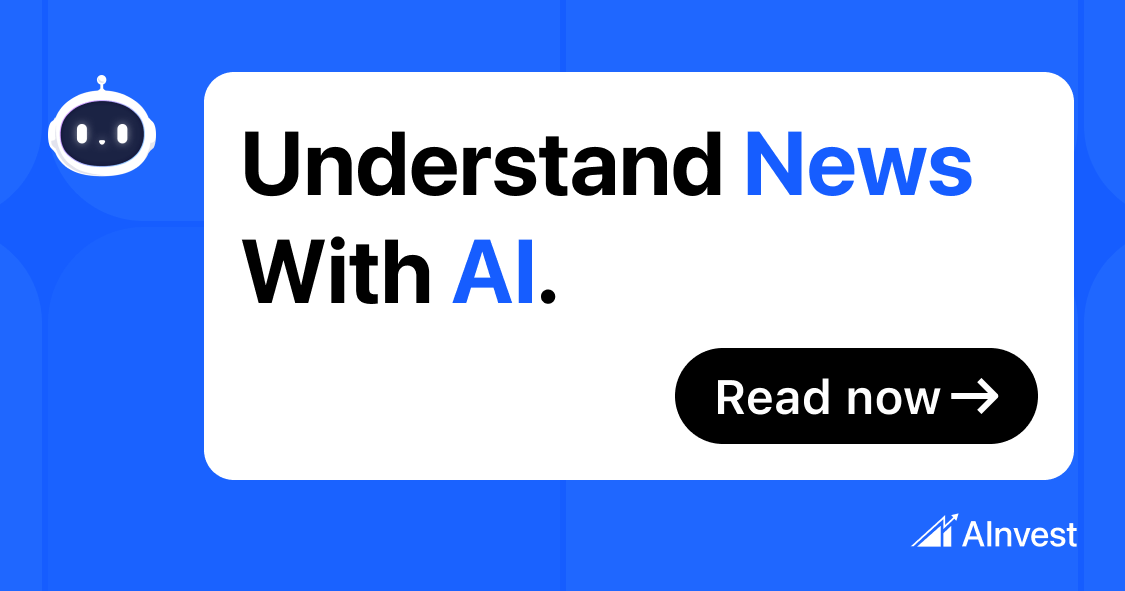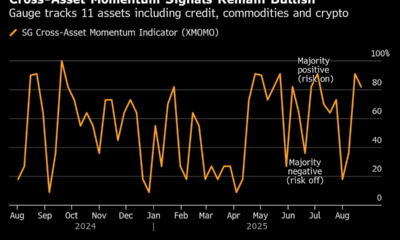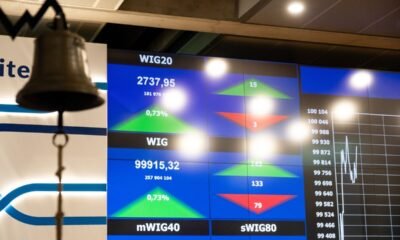Tools & Platforms
UiPath vs. AppLovin: Which AI-Driven Tech Stock is Purchase-Worthy? – July 25, 2025

Key Takeaways
- PATH leads the RPA space with strong enterprise ties, recurring revenues and 12% ARR growth.
- APP’s Axon 2 quadrupled ad spend and revived growth despite stagnation in mobile gaming.
- PATH trades at 4.09X forward sales vs. APPs 19.88X, making it the more attractive valuation play.
UiPath (PATH – Free Report) and AppLovin Corporation (APP – Free Report) are two prominent players leveraging artificial intelligence to transform digital operations. UiPath leads the robotic process automation sector (RPA), applying AI to streamline enterprise workflows.AppLovin, on the other hand, operates in the mobile ad tech space, using AI to optimize app monetization and user acquisition.
As AI becomes an integral part of modern business software, the key question is: Which of these AI-driven tech stocks presents a more compelling investment opportunity today? Let’s examine their fundamentals, growth drivers and valuations.
The Case for UiPath
UiPath remains a strong force in the booming RPA market, which is poised for substantial expansion over the coming years. Its end-to-end automation platform positions the company to seize opportunities as demand for AI-driven solutions surges.
A critical driver of PATH’s success is its strategic alliances with top technology giants. Microsoft (MSFT – Free Report) , Amazon (AMZN – Free Report) and Salesforce (CRM – Free Report) continue to play pivotal roles in expanding UiPath’s reach and capabilities. These partnerships not only bolster PATH’s credibility but also integrate its offerings into broader enterprise ecosystems powered by Microsoft Azure, Amazon’s AWS and Salesforce Cloud solutions.
The company boasts high customer retention, with net retention rates ranging between 110% and 115%, underscoring its ability to expand usage within existing accounts. In the first quarter of fiscal 2026, UiPath reported a 6% increase in revenues year over year, reaching $357 million. Additionally, its annual recurring revenue rose 12% to $1.69 billion, reflecting the strength of its subscription-based business model and customer loyalty.
With a strong global presence, a robust partner ecosystem, particularly with Microsoft, Amazon, and Salesforce, and a continued focus on intelligent automation, UiPath is well-positioned to maintain its leadership in the evolving RPA and enterprise automation market.
The Case for AppLovin
AppLovin has solidified its leadership in mobile advertising, powered by its next-gen AI engine, Axon 2, which launched in the second quarter of 2023. Since its debut, Axon 2 has radically enhanced AppLovin’s ad performance, helping to quadruple advertising spend on its platform.
This explosive growth has led to an estimated $10 billion annual run rate in ad spend from gaming clients, pushing APP into the upper echelon of global ad tech firms by valuation.
Axon 2’s importance goes far beyond mere optimization. In a post-Identifier for Advertisers environment that disrupted mobile user acquisition strategies, Axon 2 served as a critical catalyst for recovery. While Western mobile gaming experienced stagnation in 2022, Axon 2 reignited ad-driven momentum. Though in-app purchases are seeing modest, mid-single-digit growth, AppLovin’s MAX publisher base is expanding at a significantly faster rate, underscoring Axon 2’s strategic advantage.
Google, Microsoft and Salesforce are rapidly advancing generative AI. Microsoft integrates AI in Office via Copilot and expands Azure’s AI. Google embeds AI in Workspace and enhances Vertex AI. Salesforce incorporates AI across its CRM, especially through Einstein Copilot and Data Cloud. Microsoft is also focusing on AI governance, while Google is strengthening AI security. Salesforce further refines dynamic customer experiences.
While these giants focus on enterprise productivity and CRM, Applovintakes a different route, using AI to drive direct monetization in mobile advertising.
How Do Zacks Estimates Compare for PATH & APP?
The Zacks Consensus Estimate for UiPath’s 2025 sales and EPS indicates year-over-year growth of 8.5% and 5.7%, respectively. EPS estimates have been trending flat over the past 60 days.
Image Source: Zacks Investment Research
The Zacks Consensus Estimate for AppLovin’s 2025 sales and EPS indicates year-over-year growth of 16.3% and 85.4%, respectively. Both upward and downward EPS revisions have offset each other, keeping estimates flat over the past 60 days.

Image Source: Zacks Investment Research
UiPath’s Valuation More Attractive Than AppLovin
UiPath is trading at a forward sales multiple of 4.09X, below its 12-month median of 4.44X. AppLovin’s forward sales multiple stands at 19.88X, above its median of 18.7X.
Winner: UiPath
UiPath emerges as the more compelling AI-driven investment. While AppLovin dazzles with Axon 2 and ad spend growth, UiPath’s leadership in the fast-expanding RPA market, strong enterprise partnerships with Microsoft, Amazon, and Salesforce, and high customer retention offer long-term stability. Its subscription-based model ensures recurring revenue, and its valuation — trading at a much lower forward sales multiple than AppLovin — makes it a better value play. UiPath’s enterprise focus and strategic alliances give it an edge in AI scalability and business relevance. For investors seeking sustainable, enterprise-grade AI exposure, UiPath stands out as the smarter buy.
While PATH sports a Zacks Rank #1 (Strong Buy), APP carries a Zacks Rank #3 (Hold). You can see the complete list of today’s Zacks #1 Rank stocks here.
Tools & Platforms
How American Workers Over 80 Are Embracing AI, ‘Want to Finish Strong’

Luis Bautista, 82, is “learning to speak to AI.”
He’s studying prompt engineering strategies online, reading about the companies accepted into Y Combinator, and watching AI videos on YouTube.
“When I turned 80, I asked myself, ‘How do I want to finish?'” Bautista said. “The first answer that came to my mind was, ‘I want to finish strong.’ Then I need to learn AI.”
He also needs to keep working. He has less than $100 in savings and lives on a monthly budget of about $1,000 in Social Security and $1,000 from working as a life coach and business advisor, including for a tech startup he cofounded.
Bautista is studying AI to help write a book on spiritual living. He can’t afford to take classes, so he’s getting up to speed using free websites and picking up tips from contacts.
“I’m finding techniques and methodologies to transcend these moments of uncertainty, anxiety, and depression,” said Bautista. “If this tech startup happens the way I see it can happen, then I’ll be in a period of prosperity.”
Cassidy Araiza for Business Insider
In recent months, Business Insider has interviewed over 130 Americans working in their 80s and 90s about their careers, finances, relationship with technology, and more. Many said they haven’t experimented with AI, felt little need to learn it, or suspect it could harm them.
One 94-year-old worker said it would “take away more of the ability for people to use their own heads,” while another in his 80s feared it would eliminate jobs for “older people who don’t trust it.” Some worried AI could make them vulnerable to scams, lead them to believe fabricated information, or screen out their job applications based on age.
More than 40 said they’re actively embracing AI for work or daily tasks. Most use the free version of OpenAI’s ChatGPT, and a handful have experimented with assistants like Anthropic’s Claude or Google’s Gemini. A few are more advanced, taking machine learning classes or integrating technical AI models into their workflows. Some are learning AI to stay marketable, while others hope to boost their income in hopes of retiring. A few said they’re mandated to use it at work.
“I’m more aware of AI than probably most older adults,” said Herbert Dwyer, 84, who is the chief technology officer for a company building thermal sensors for aerospace applications. That’s more necessity than choice because some of the programs he uses rely on AI. He’s not involved in more common uses like prompt engineering, and he describes his AI involvement as “on the fringes.”
Phyllis Scalettar, on the other hand, is jumping in with both feet. She’ll turn 80 in October and runs an AI education and consulting firm enabling clients, including older adults, to improve work processes, performance, and productivity. Scalettar, who has a Ph.D., uses Perplexity and Claude, and relies on Stable Diffusion for image generation and Infogram for charts. She also employs Hive Moderation and Winston AI to detect AI-generated content.
Valerie Plesch for Business Insider
“The world is really exciting,” she said, “and I’ve embraced technology because that is the way we live.”
‘I’m sure that when automobiles came out, people were scared to death, too.’
Older Americans could be at the forefront of AI implementation, said Catherine Collinson, CEO and president of the nonprofit Transamerica Institute. They’ve lived through massive technology advancements — when the youngest of the Silent Generation entered the workforce, early computers were just coming out.
“Imagine a workforce that brings eight decades of life experience, and then five or six or more decades of work experience,” Collinson said.
Scalettar is using her experience in the private sector at the Dun & Bradstreet Corporation and the public sector workforce, including at the IRS and the Chemical Safety Board, to make AI more accessible to her clients through her firm, AIdology, LLC. She became a certified AI consultant after completing a machine learning course in 2023 and additional training on no-code AI tools. She doesn’t think older workers should be afraid of new technology.
Valerie Plesch for Business Insider
“I’m sure that when automobiles came out, people were scared to death, too,” she said.
While much of the discussion around AI has focused on its potential to replace entry-level jobs, researchers told BI that older workers may feel a greater impact of these technologies than their younger colleagues. That’s because they’re less mobile across employers or occupations and face lower reemployment chances, said International Monetary Fund economists Carlo Pizzinelli and Marina Mendes Tavares, drawing from research they published in July.
Older workers are also vulnerable because they aren’t adopting AI as fast as other generations, in part due to a lack of training. A 2024 survey by the employment nonprofit Generation found that 13% of workers over the age of 45 use generative AI tools at work. Most of those workers were self-taught and reported improvements in productivity and work quality. Among those not using AI, 24% were interested in learning.
However, among US hiring managers, 7% said in Generation’s survey that they were very likely to consider candidates 65 and older for jobs that regularly use AI tools, compared to 57% for applicants ages 25 to 34. Over half said they were not very likely or not at all likely to consider an applicant 65 and older.
“There is a financial fragility that many are experiencing, which forces them to continue working, but the level of bias in the workplace goes up dramatically once you are past age 45,” said Generation CEO Mona Mourshed, adding that companies are still figuring out how AI is going to be useful.
Scalettar seems to have a clear vision for her new skillset. Her recent client requests include a company looking to expand its reach overseas and a veterinary practice wondering how to scale its business. She’s developed training materials on prompt engineering and working with an AI assistant. She also taught her husband, 96, how to be more productive by using AI tools as his research assistant and book editor.
“The best gift you can give somebody is a wide perspective on their life, their capabilities, and what they can contribute,” Scalettar said. “If I can share that with others through AI, if I can show people that there is much to be learned, that’s the gift I could give.”
The 80-year-old AI student
Online and in-person AI classes are proliferating as AI becomes more integrated into the workforce. Some classes are focused on the basics, such as detecting fake information, while others are career-focused.
Marisa Giorgi, director of curriculum development at Older Adults Technology Services, an AARP subsidiary, said older workers have been craving more resources to improve their AI acumen. OATS offers 11 Senior Planet AI courses, including one designed for small businesses that covers using AI to craft social media posts or identify purchasing trends.
“We don’t believe that there’s any time, that there’s any point in time in life, where you should stop learning or being curious,” Giorgi said.
At an August Senior Planet class in New York City titled Introduction to Chatting with AI, nearly two dozen students 60 and older learned about ChatGPT, Gemini, and Microsoft’s CoPilot. Four students in their 60s and 70s told Business Insider they hoped to use AI to apply for jobs, search for a new home, or create art.
Clark Hodgin for Business Insider
Margaret Sass, who teaches an AI for seniors class at Boise State University, said most participants use what they learn for personal tasks, such as planning vacations. A few, including a therapist, use it actively at work. Most don’t realize how much they’re already using AI — like any time they search on Google. Sass said she’s recently taught students about AI wearables and introduced AI personas to the class.
“I am hoping that it also might help their creativity as they become older, because I think that’s good for mental health,” Sass said. “I’ve been looking into how they can write their own songs. There are also virtual walking tours, conferences, and musicals they can do from their home with the use of AI.”
AI is sometimes essential to paying the bills
Katherine Cavanaugh, 83, is learning to use AI for the consulting company she created, which bids on curriculum design contracts with hospitals and academic institutions. Her income is around $42,000 annually, and, between her savings and home equity, her net worth is less than $100,000. Cavanaugh says she’s financially strained, in part due to a mid-career period of short-term contracts and unemployment.
AI often lacks emotional intelligence, Cavanaugh said, though it’s helpful for lesson planning or preparing research advice for students working on dissertations. She predicts AI will come in handy for developing course curricula, and she already uses Perplexity and DeepSeek for her work.
“There was a fear that we were all going to lose our teaching positions because they were going to rely on AI teachers solely,” Cavanaugh said, adding that she doesn’t think the tech is ready for that yet.
Steve Preston, CEO of Goodwill Industries International and former Administrator of the Small Business Administration, said thousands of older Americans in precarious financial situations have received AI training from a Goodwill partnership with Google, which he hopes will be a “door opener.” The aim for participants in the program, which gives job training to lower-income, unemployed adults ages 55 and older, is to earn AI certifications in order to land better jobs.
“Traditional technology can be a barrier for older people that requires a fair bit of training depending on what level you want to reach,” Preston said. “AI can leapfrog a lot of that training” because it’s easier to use.
Jacqueline Steubbel, 81, works to pay for basic living expenses and uses AI to boost her productivity.
Steubbel, who lives in Tennessee, worked as a copy editor for a newspaper while raising her four children. Two years ago, she secured a job as a psychiatric drug and alcohol addiction counselor, taking pride in helping many get back on track.
Steubbel said she’s watched videos about how to use ChatGPT and other tools at work. She employs it to search case histories for her patients and copyedit a nonfiction book she’s writing. She suspects AI will be crucial to advancing medicine in her field, but will never replace the human side of counseling.
“I’ve had a lot of good experiences,” Steubbel said. “It would be a shame not to leave some of that residue as I continue what I call my trek across the crackling Earth.”
Tools & Platforms
Can AI teach us how animals think?

Now we have a better idea, thanks to a Milan-based researcher who has developed an AI model that he claims can detect whether their calls express positive or negative emotions.
Stavros Ntalampiras’s deep-learning model, which was published in Scientific Reports, can recognise emotional tones across seven species of hoofed animals, including pigs, goats and cows. The model picks up on shared features of their calls, such as pitch, frequency range and tonal quality.
The analysis showed that negative calls tended to be more mid to high frequency, while positive calls were spread more evenly across the spectrum. In pigs, high-pitched calls were especially informative, whereas in sheep and horses the mid-range carried more weight, a sign that animals share some common markers of emotion but also express them in ways that vary by species.
For scientists who have long tried to untangle animal signals, this discovery of emotional traits across species is the latest leap forward in a field that is being transformed by AI.
The implications are far-reaching. Farmers could receive earlier warnings of livestock stress, conservationists might monitor the emotional health of wild populations remotely, and zookeepers could respond more quickly to subtle welfare changes.
This potential for a new layer of insight into the animal world also raises ethical questions. If an algorithm can reliably detect when an animal is in distress, what responsibility do humans have to act? And how do we guard against over-generalisation, where we assume that all signs of arousal mean the same thing in every species?
Of barks and buzzes
Tools like the one devised by Ntalampiras are not being trained to “translate” animals in a human sense, but to detect behavioural and acoustic patterns too subtle for us to perceive unaided.
Similar work is underway with whales, where New York-based research organisation Project Ceti (the Cetacean Translation Initiative) is analysing patterned click sequences called codas.
Long believed to encode social meaning, these are now being mapped at scale using machine learning, revealing patterns that may correspond to each whale’s identity, affiliation or emotional state.
In dogs, researchers are linking facial expressions, vocalisations and tail-wagging patterns with emotional states. One study showed that subtle shifts in canine facial muscles correspond to fear or excitement. Another found that tail-wag direction varies depending on whether a dog encounters a familiar friend or a potential threat.
At Dublin City University’s Insight Centre for Data Analytics, we are developing a detection collar worn by assistance dogs which are trained to recognise the onset of a seizure in people who suffer from epilepsy. The collar uses sensors to pick up on a dog’s trained behaviours, such as spinning, which raise the alarm that their owner is about to have a seizure.
The project, funded by Research Ireland, strives to demonstrate how AI can leverage animal communication to improve safety, support timely intervention, and enhance quality of life. In future we aim to train the model to recognise instinctive dog behaviours such as pawing, nudging or barking.
Honeybees, too, are under AI’s lens. Their intricate waggle dances – figure-of-eight movements that indicate food sources – are being decoded in real time with computer vision. These models highlight how small positional shifts influence how well other bees interpret the message.
Caveats
These systems promise real gains in animal welfare and safety. A collar that senses the first signs of stress in a working dog could spare it from exhaustion. A dairy herd monitored by vision-based AI might get treatment for illness hours or days sooner than a farmer would notice.
Detecting a cry of distress is not the same as understanding what it means, however. AI can show that two whale codas often occur together, or that a pig’s squeal shares features with a goat’s bleat. The Milan study goes further by classifying such calls as broadly positive or negative, but even this remains using pattern recognition to try to decode emotions.
Emotional classifiers risk flattening rich behaviours into crude binaries of happy/sad or calm/stressed, such as logging a dog’s tail wag as “consent” when it can sometimes signal stress. As Ntalampiras notes in his study, pattern recognition is not the same as understanding.
One solution is for researchers to develop models that integrate vocal data with visual cues, such as posture or facial expression, and even physiological signals such as heart rate, to build more reliable indicators of how animals are feeling.
AI models are also going to be most reliable when interpreted in context, alongside the knowledge of someone experienced with the species.
It’s also worth bearing in mind that the ecological price of listening is high. Using AI adds carbon costs that, in fragile ecosystems, undercut the very conservation goals they claim to serve. It’s therefore important that any technologies genuinely serve animal welfare, rather than simply satisfying human curiosity.
Whether we welcome it or not, AI is here. Machines are now decoding signals that evolution honed long before us, and will continue to get better at it.
The real test, though, is not how well we listen, but what we’re prepared to do with what we hear. If we burn energy decoding animal signals but only use the information to exploit them, or manage them more tightly, it’s not science that falls short – it’s us.
Tools & Platforms
Is It a High-Conviction Buy Amid AI Infrastructure Growth and Energy Constraints?

The AI infrastructure boom has created a seismic shift in the tech landscape, with data centers demanding unprecedented speed, scalability, and energy efficiency. Credo Technology (CRDO) has emerged as a pivotal player in this transformation, leveraging its high-speed connectivity solutions to address the dual challenges of performance and power consumption. However, as the sector grapples with energy bottlenecks and intensifying competition, investors must weigh CRDO’s strategic advantages against its macro risks.
Financial Strength and Strategic Innovation
Credo’s fiscal 2025 results underscore its rapid ascent: revenue surged to $436.77 million, a 126.34% year-over-year increase, while net income jumped 283.94% to $52.18 million [3]. This growth is fueled by demand for its Active Electrical Cables (AECs) and optical digital signal processors (DSPs), which offer 50% lower power consumption and 100x greater reliability than traditional optical solutions [1]. The company’s gross margin of 64.77% and a cash balance of $236.33 million further highlight its financial discipline [3].
Credo’s system-level strategy—integrating SerDes IP, Retimer ICs, and the PILOT software platform—enables faster time-to-market and system-level optimization for hyperscalers [1]. Innovations like the 112G PAM4 SerDes IP and 3nm 200G-per-lane optical DSPs position it to capitalize on the industry’s shift to 200G lane speeds [3]. Analysts project revenue exceeding $800 million in 2026, with a non-GAAP net margin approaching 40% [1].
Competitive Edge in a High-Stakes Market
The AI infrastructure market is projected to grow at a 17.71% CAGR through 2030, driven by energy-efficient cooling, AI-specific networking, and government subsidies [4]. Credo’s focus on low-power, high-bandwidth interconnects aligns with this trajectory. Its AECs, which dominate hyperscaler demand, have driven double-digit sequential growth, while its 3nm optical DSP supports port speeds up to 1.6 Tbps [1].
However, competitors like Broadcom and Marvell are also advancing optical connectivity and custom silicon solutions [2]. Credo’s pure-play focus on high-speed connectivity and proprietary technologies, such as the PILOT platform, provides differentiation. Its 33.4% R&D investment ratio reinforces innovation cycles, a critical edge in a capital-intensive industry [3].
Navigating Energy Constraints and Macro Risks
AI data centers face existential energy challenges. Grid capacity constraints, with 72% of respondents in a Deloitte 2025 survey citing it as a “very challenging” issue, threaten to delay 20% of planned projects [1]. Credo’s energy-efficient solutions mitigate this risk, but the broader industry’s reliance on fossil fuels to meet AI’s power demands raises sustainability concerns [6].
Customer concentration remains a vulnerability: Microsoft accounted for 86% of Q3 2025 revenue [5]. While Credo is diversifying into new hyperscaler relationships and the PCIe retimers market, overreliance on a few clients could destabilize growth. Additionally, its forward 12-month Price/Sales ratio of 26.02, well above the sector average of 8.83, suggests valuation risks [5].
Analyst Outlook and Strategic Resilience
Despite these risks, analysts remain bullish. Mizuho raised its price target to $135, citing Credo’s leadership in AI infrastructure, while Stifel set a $115 target [2]. TD Cowen labeled CRDO its “Best Smidcap Idea for 2025,” emphasizing its role in hyperscaler AI adoption [5]. Post-patent settlement, Credo’s legal risks have diminished, opening avenues for licensing revenue [5].
Conclusion: A High-Conviction Buy?
Credo’s strategic positioning in the AI infrastructure boom is compelling. Its energy-efficient solutions, robust financials, and system-level innovation address critical industry pain points. Yet, energy bottlenecks, competitive pressures, and valuation concerns demand caution. For investors with a long-term horizon and a tolerance for volatility, CRDO’s projected 85%+ revenue growth and strong balance sheet justify a high-conviction buy, provided diversification and sustainability risks are monitored.
Source:
[1] Credo Technology and the AI Infrastructure Boom [https://www.ainvest.com/news/credo-technology-ai-infrastructure-boom-strategic-play-data-center-revolution-2508/]
[2] How Does Credo’s System-Level Strategy Provide an Edge in the AI Era [https://www.nasdaq.com/articles/how-does-credos-system-level-strategy-provide-edge-ai-era]
[3] Credo Technology Group Holding Ltd (CRDO) Financial & [https://www.monexa.ai/blog/credo-technology-group-holding-ltd-crdo-financial–CRDO-2025-08-06]
[4] AI Infrastructure Market Statistics: Size, Growth, & Trends [https://thenetworkinstallers.com/blog/ai-infrastructure-market-statistics/]
[5] Credo Technology (CRDO): AI Growth, Risks, and Market Outlook [https://www.monexa.ai/blog/credo-technology-crdo-ai-growth-risks-and-market-o-CRDO-2025-03-06]
[6] The growing environmental impact of AI data centers’ energy demands [https://www.pbs.org/newshour/show/the-growing-environmental-impact-of-ai-data-centers-energy-demands]
-
Tools & Platforms3 weeks ago
Building Trust in Military AI Starts with Opening the Black Box – War on the Rocks
-

 Ethics & Policy1 month ago
Ethics & Policy1 month agoSDAIA Supports Saudi Arabia’s Leadership in Shaping Global AI Ethics, Policy, and Research – وكالة الأنباء السعودية
-

 Events & Conferences3 months ago
Events & Conferences3 months agoJourney to 1000 models: Scaling Instagram’s recommendation system
-

 Business2 days ago
Business2 days agoThe Guardian view on Trump and the Fed: independence is no substitute for accountability | Editorial
-

 Jobs & Careers2 months ago
Jobs & Careers2 months agoMumbai-based Perplexity Alternative Has 60k+ Users Without Funding
-

 Funding & Business2 months ago
Funding & Business2 months agoKayak and Expedia race to build AI travel agents that turn social posts into itineraries
-

 Education2 months ago
Education2 months agoVEX Robotics launches AI-powered classroom robotics system
-

 Podcasts & Talks2 months ago
Podcasts & Talks2 months agoHappy 4th of July! 🎆 Made with Veo 3 in Gemini
-

 Podcasts & Talks2 months ago
Podcasts & Talks2 months agoOpenAI 🤝 @teamganassi
-

 Jobs & Careers2 months ago
Jobs & Careers2 months agoAstrophel Aerospace Raises ₹6.84 Crore to Build Reusable Launch Vehicle






















